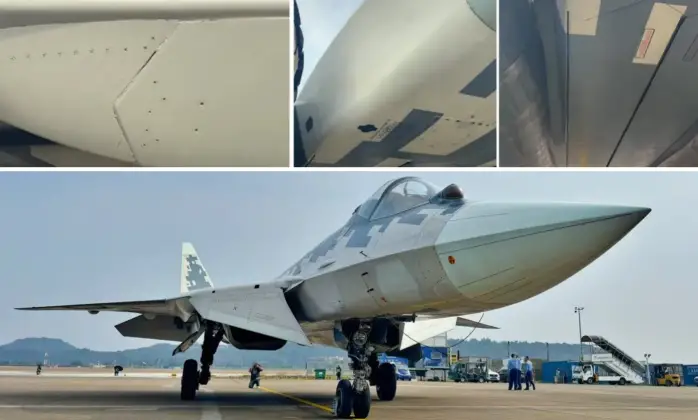<p >The Russian Su-57 fifth generation fighter is set to make its first appearance at a foreign airshow, as confirmed by the arrival of two of the aircraft in Guangdong, China, to participate in the&nbsp;China International Aviation &amp; Aerospace Exhibition – an event better known as the Zhuhai Air Show. The first of the aircraft arrived on November 3, flying from Russia with a fuel stop at Taiyuan Wusu International Airport in northern China, while second was delivered for static display on an An-124 heavy airlifter. Spectators were given unprecedented access to the flightworthy aircraft, with close up pictures widely being shared in the Western world to assert that the fighter program suffers from a highly questionable manufacturing quality. Pictures did indeed show use of visible bolts, poor panel fitting, inconsistencies in assembly, and use of bolts with varying head types. With visible gaps between many of the aircraft’s surfaces, and prominent screws and rivets, the fighter displayed was indeed decades behind prevailing developments in stealth technologies, and failed to provide a genuinely fifth generation low observable capability.</p><p ><img src=" title="Su-57 at Zhuhai 2024"></p><p >While the Su-57 displayed was far from stealthy, this hardly reflected poorly on the overall program. This was due to the fact that the fighter was not a serial production model, but an early prototype – namely airframe T-50-4 which was only the fourth prototype ever built in the early 2010s. The second aircraft delivered for static display, too, was only slight better, and was prototype number T-50-7. Individually built prototype aircraft across all fifth generation fighter programs have been far from stealthy, with Western sources seeking to criticise Russia’s combat aviation industry having consistently published pictures of Su-57 prototypes to assert that Russian industry’s attempt to produce a stealth fighter has resulted in a very poor quality aircraft. While there is little double that the Su-57 is less stealthy than the latest <a href=" target="_blank">Chinese J-20</a> and <a href=" target="_blank">American F-35 </a>fifth generation fighters, the Russian aircraft’s stealth capabilities are nevertheless considered respectable with the quality of serial production aircraft shown to be high. The Russian Defence Ministry released the <a href=" images </a>of the Su-57s in serial production in August 2020, with indicators such as the tolerances on the skin panels highlighting a far superior production quality.&nbsp;</p><p ><img src=" title="Su-57 (T-50-7) is Unloaded From An-124 at Zhuhai "></p><p >The decision to send Su-57 prototypes to the Zhuhai Airshow, and to allow close inspection of the airframes, may well prove detrimental to the program’s reputation by allowing a highly misleading narrative to be propagated regarding the aircraft’s poor production quality. While under normal circumstances it would be expected that serial production aircraft from one of the latest production batches would be displayed, the fact that Russia is currently in a state of conflict with Ukraine and a <a href=" of Western countries</a> has made it difficult to spare the fifth generation fighters from the frontlines. Russia fields less than two regiments of Su-57s between them deploying an estimated 30 or so fighters, with just <a href=" having been in service</a> at the beginning of the year. Arguably the greatest shortfall of the Su-57 program is not the quality of the aircraft, but rather the serious delays to beginning production, leaving the Air Force far short of the fleet of <a href=" target="_blank">200 fighters initially planned</a> to be in service by 2025.&nbsp;</p><p ><img src=" title="Su-57 (T-50-4) Lands at Zhuhai "></p><p >Su-57s have used their stealth capabilities to operate in areas with high concentrations of Ukrainian air defences, most notably in early October when one of the aircraft was<a href=" >&nbsp;used to shoot down</a>&nbsp;a Russian S-70 drone prototype which appeared set to crash in Ukrainian-held or NATO territory.&nbsp;The fighters have been employed for precision strike and&nbsp;<a href=" >air defence suppression</a>&nbsp;missions, with initial reports of Su-57s being deployed for&nbsp;<a href=" >air to air combat&nbsp;</a>being supported by a later&nbsp;<a href=" >report in January 2023&nbsp;</a>by the British Ministry of Defence that the fighters were “launching long range air to surface or air to air missiles into Ukraine.” Although fielded in limited numbers, the aircraft have by far the greatest levels of use in high intensity combat of any from their generation, and provide a range of unique capabilities in the Ukrainian theatre that have led them to be used with growing intensity. The fact that the Russian Air Force was unable to spare even a single serial production fighter for the air show at Zhuhai has accordingly been interpreted to highlight the value attributed to the aircraft in ongoing operations.&nbsp;&nbsp;</p>
Zhuhai Airshow: Why Criticism of the Russian Su-57 Fighter’s Production Quality is Misplaced

